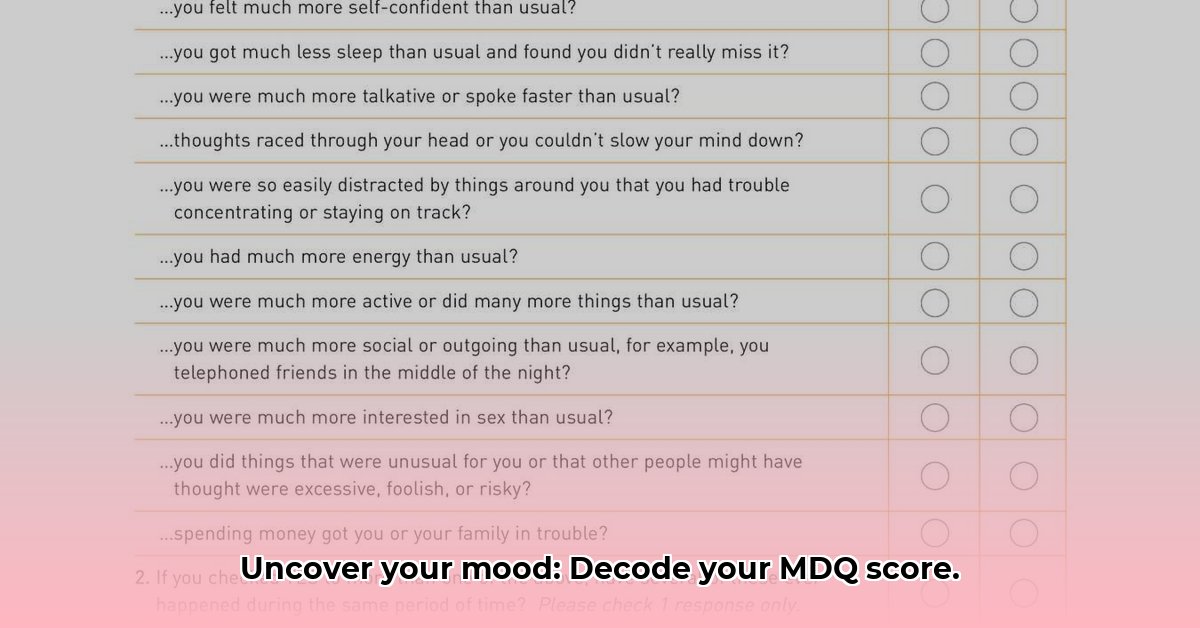This guide provides a clear, step-by-step approach to understanding and scoring the Mood Disorder Questionnaire (MDQ). We’ll cover how to interpret your results and what to do next. Think of this as your friendly, supportive guide to navigating the MDQ.
What is the MDQ and How Does it Work?
The MDQ is a screening tool, not a diagnostic test, designed to help identify individuals who might have bipolar disorder. It’s like a first step, a quick check to see if further evaluation by a mental health professional is recommended.
The MDQ consists of 15 questions, divided into two parts:
Part 1: Symptom Checklist (Questions 1-13)
This section asks about common symptoms associated with mood episodes. You simply answer “yes” or “no” to each question based on whether you’ve experienced these symptoms within the same two-week period.
Part 2: Timing and Impact (Questions 14-15)
Question 14 asks if several of the symptoms from Part 1 occurred at the same time. Question 15 explores how much these symptoms affected your daily life.
Scoring the MDQ: A Step-by-Step Guide
-
Count Your “Yes” Answers (Part 1): Tally the number of “yes” responses to questions 1-13.
-
Check Question 14: Did several of these symptoms occur around the same time? If not, your screening result is likely negative.
-
Consider the Impact (Question 15): Did these mood changes cause moderate or serious problems in your daily life? If not, your screening result is likely negative.
Interpreting Your Score:
-
Positive Screen: Seven or more “yes” answers in Part 1, along with “yes” to question 14 and “moderate” or “serious” to question 15. This suggests the possibility of bipolar disorder and indicates the need for professional evaluation.
-
Negative Screen: Doesn’t meet the criteria for a positive screen. While this generally suggests a lower likelihood of bipolar disorder based on this tool alone, it’s important to discuss any concerns with a doctor, especially if you are experiencing distressing symptoms.
Example Scenario
Imagine someone answered “yes” to eight of the first 13 questions, “yes” to question 14, and “moderate” to question 15. This would be a positive screen. However, if they chose “mild” or “no problem” for question 15, the result would be negative.
Understanding Your MDQ Results
A positive MDQ screen does not confirm a bipolar disorder diagnosis. Many factors can influence mood, including stress, other health conditions, and life events. A positive screen simply signals the need for a more comprehensive assessment by a healthcare professional.
Even with a negative screen, it’s wise to talk to a doctor if you’re worried about your moods. They can offer reassurance, explore other potential causes, and provide support.
MDQ Limitations: Screening vs. Diagnosis
The MDQ is a helpful tool, but it has limitations:
-
Not a Diagnostic Test: The MDQ is a screening tool, like a metal detector, not a diagnostic test, like digging to see what the metal detector found. It helps identify individuals who might benefit from further evaluation, but it can’t provide a diagnosis on its own.
-
False Positives and False Negatives: Like any screening tool, the MDQ isn’t perfect. It’s possible to have a positive screen and not have bipolar disorder (false positive) or have bipolar disorder and receive a negative screen (false negative).
-
Focus on Bipolar I: The MDQ is generally better at detecting Bipolar I, with its more pronounced manic episodes, than Bipolar II, which features less intense hypomania. Individual experiences of bipolar disorder can vary greatly.
-
Self-Reporting: The MDQ relies on self-reported information, which can be influenced by memory and current mood.
-
Overlapping Symptoms: Some symptoms assessed by the MDQ can also occur in other conditions, such as anxiety disorders or depression.
What to Do After Taking the MDQ
Regardless of your MDQ score, if you’re concerned about your mental well-being, talk to a healthcare professional. They can provide personalized guidance, considering your individual history and circumstances. They can conduct a comprehensive evaluation, including interviews, questionnaires, and a review of your medical and family history, to determine the most appropriate course of action.
Finding Professional Help
- Your primary care doctor is a good starting point. They can refer you to specialists like psychiatrists or psychologists.
- The National Institute of Mental Health (NIMH) provides resources and information on finding mental health services.
- The Substance Abuse and Mental Health Services Administration (SAMHSA) offers a national helpline and online resources.
Remember, seeking professional support is a sign of strength. Taking care of your mental health is essential. You are not alone. Ongoing research continues to deepen our understanding of mood disorders, offering hope for improved diagnosis and treatment.
- Water Wheel Electric Generator Provides Free Home Electricity - December 15, 2025
- Choosing the Right Portable Hydro Turbine for Your Needs - December 14, 2025
- Best Portable Hydro Generators for Off-Grid and Outdoor Power - December 13, 2025
















